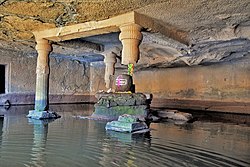
Back সত্যযুগ Assamese সত্য যুগ Bengali/Bangla Satya-Yuga German Satya Yuga Spanish ساتیا یوگا Persian Satya Yuga Finnish Satya Yuga French સત્યયુગ Gujarati सत्य युग Hindi Szatja-juga Hungarian

| Part of a series on |
| Utopias |
|---|
 |
| Mythical and religious |
| Literature |
| Theory |
| Concepts |
| Practice |
|
Satya Yuga (a.k.a. Krita Yuga) (IAST: Kṛta-yuga), in Hinduism, is the first and best of the four yugas (world ages) in a Yuga Cycle, preceded by Kali Yuga of the previous cycle and followed by Treta Yuga.[1][2] Satya Yuga lasts for 1,728,000 years (4,800 divine years).[3][4][5]
Satya Yuga is known as the age of truth, when humanity is governed by gods, and every manifestation or work is close to the purest ideal and humanity will allow intrinsic goodness to rule supreme. It is sometimes referred to as the "Golden Age".[6] Dharma (depicted in the form of a bull) symbolizes morality and stood on all four legs during this period; the legs of Dharma reduce by one in each yuga that follows.[7] As per Bhagavata Purana, the four legs of Dharma are Tapas lit. 'austerity', Śauca lit. 'cleanliness' (or Dāna lit. 'charity'), Dayā lit. 'compassion ' and Satya lit. 'truth'.[8][9]
- ^ "yuga". Dictionary.com Unabridged (Online). n.d. Retrieved 27 February 2021.
- ^ "satya yuga". Dictionary.com Unabridged (Online). n.d. Retrieved 27 February 2021.
- ^ Cite error: The named reference
Godwin 2011was invoked but never defined (see the help page). - ^ Cite error: The named reference
Merriam-Websterwas invoked but never defined (see the help page). - ^ Cite error: The named reference
Springer measurementswas invoked but never defined (see the help page). - ^ Premánand Bhárati, Bábá (1904). Sree Krishna, the lord of love. Harvard University. London : W. Rider. p. 99.
- ^ Seth, Kailash Nath; Chaturvedi, B. K. (2000) [1993]. Gods And Goddesses Of India. Diamond Pocket Books. p. 109. ISBN 9788171820696.
- ^ Purāṇam. Vol. 16. Varanasi: All-India Kasiraja Trust. 1974. p. 69.
- ^ Rocher, Ludo (1986). The Purāṇas. Vol. II. O. Harrassowitz. p. 124.